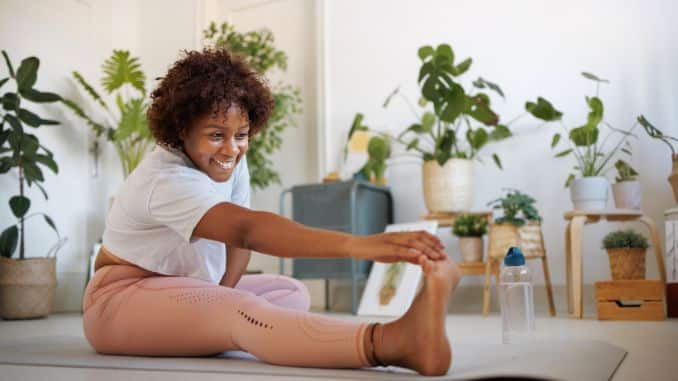Your energy doesn’t just come from coffee or sleep—it comes from movement. And strength training for energy is one of the most effective ways to power your day.
Resistance training [1] —whether with free weights, body weight, or machines—boosts your resting metabolic rate, builds muscle mass, and supports healthy blood pressure regulation. It can improve overall sleep quality over time by promoting healthy hormone balance and physical recovery.
This energizing workout combines “high-intensity” training with full-body moves that target major muscle groups and align with top physical activity guidelines. Pair it with aerobic exercise like walking or cycling for even more energy and fitness benefits.
Adding strength training to your routine supports a healthy lifestyle, enhances cardiovascular health, and helps prevent chronic disease.
Introduction to Strength Training
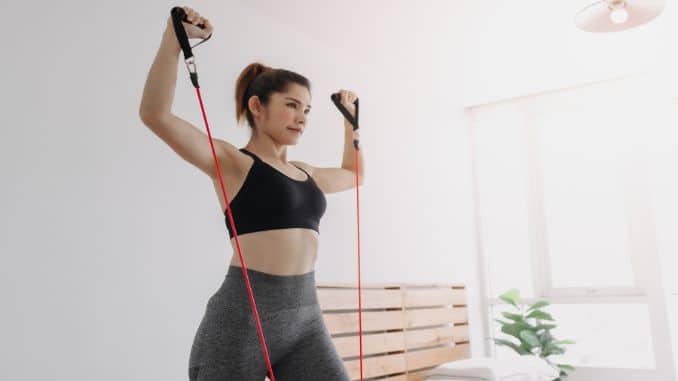
Strength training, also known as resistance training, boosts muscle strength, endurance, and energy levels by challenging your body with weights, bands, or your body weight. Strength training for energy—whether it's squats, push-ups, or resistance band workouts—activates major muscle groups and supports your overall health.
According to the U.S. Department of Health and Human Services, healthy adults should do muscle-strengthening activities at least twice per week. These sessions improve muscle mass, metabolic rate, and offer lasting health benefits. Strength training for energy is flexible and accessible—perfect for anyone looking to feel stronger and enjoy more energy throughout the day.
Benefits of Exercise
Both aerobic exercise (like walking or swimming laps) and resistance exercise training play a vital role in improving cardiovascular health [²], managing body composition, and reducing the risk of chronic disease.
A systematic review of clinical trials shows that combining aerobic training with resistance exercise is more effective for heart disease recovery than aerobic activity alone. The National Institute of Diabetes and Digestive and Kidney Diseases also recommends regular exercise to manage type 2 diabetes and other chronic conditions.
By making strength training for energy part of your routine, you’ll gain more energy, better sleep, and a stronger, healthier body—proof that physical activity is essential for lifelong wellness.
Warm-Up Phase: Prime Your Nervous System
1. Breaths
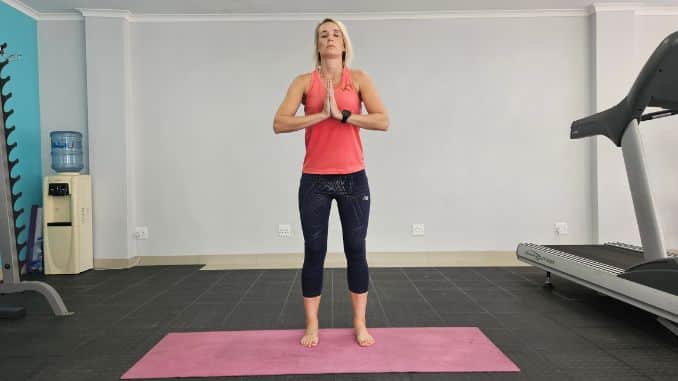
- Stand with your feet slightly wider than shoulder-width apart.
- Press your palms together at chest level.
- Take several deep belly breaths—in through your nose, out through your mouth.
- This activates your parasympathetic nervous system and prepares your muscles for resistance exercise.
2. Shoulder Rolls
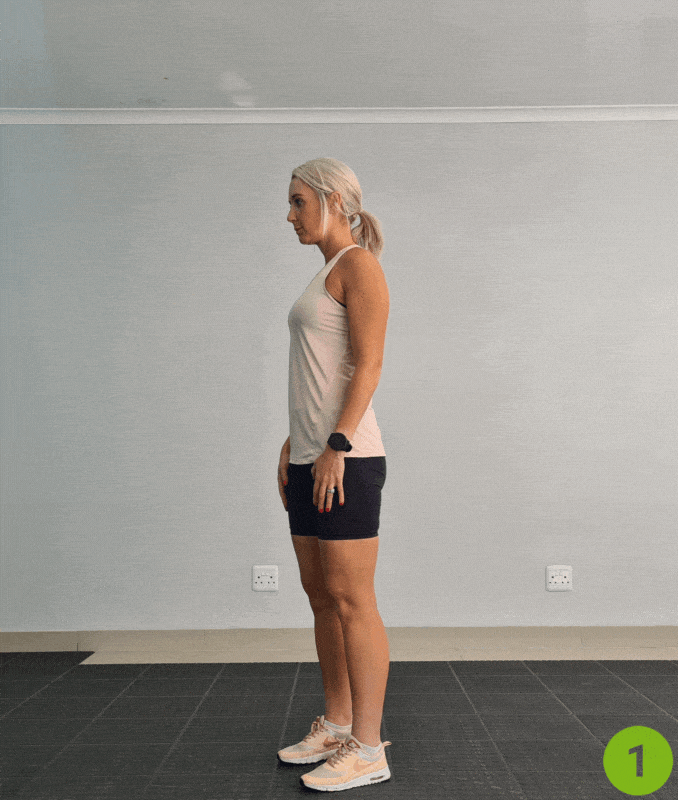
- Begin in an upright standing position with your feet shoulder-width apart, maintaining good alignment with your head, shoulders, hips, and legs.
- Place your hands on your hips.
- Engage your core. Shift your shoulders forward, then roll them up and back until you feel resistance in your shoulder blades.
- Relax and repeat the movement. Start with 10 repetitions in each direction.
3. Swimming Motion
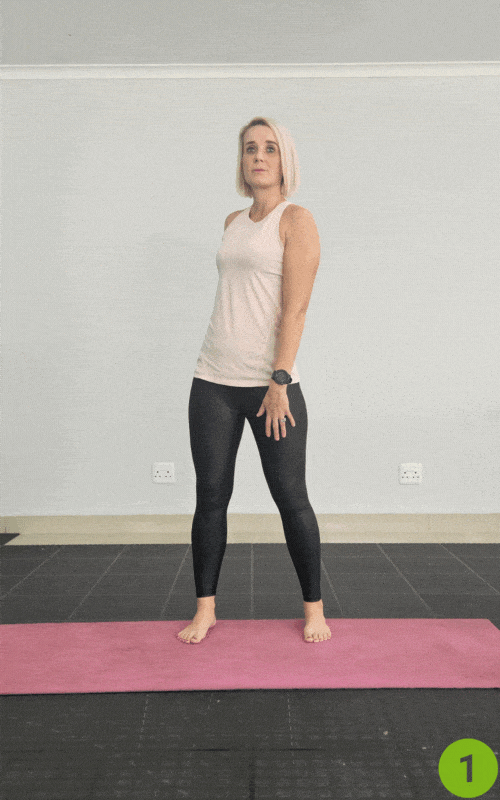
- Begin in an upright standing position with your feet shoulder-width apart, maintaining good alignment with your head, shoulders, hips, and legs.
- Place your arms at your sides. Engage your core and make a large circular motion forward with one arm, similar to a forward crawl swimming motion.
- Repeat the movement on the opposite side. Start with 10 repetitions on each side.
After completing the forward swimming motion, complete 10 repetitions on each side in the reverse direction, similar to a backward crawl.
Strength Phase: Build Muscle, Burn Fat, Boost Energy
4. Standing Resistance Rows
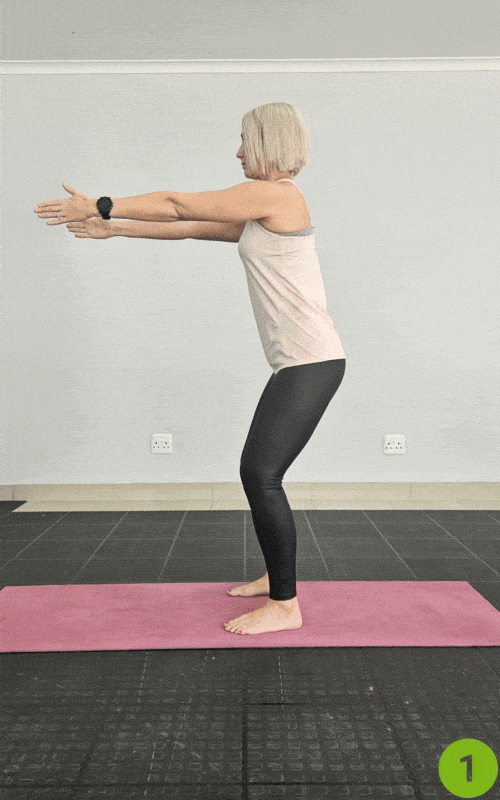
- Begin in an upright standing position with your feet slightly wider than shoulder-width apart, maintaining good alignment with your head, shoulders, and hips.
- Bend your knees and hinge through your hips to move into an athletic position.
- Extend both arms in front of your body at chest height.
- Contract your core and pull your arms back in a rowing motion, keeping your elbows at chest height and squeezing your shoulder blades together at the end position.
- Extend your arms to the starting position and repeat the movement.
- Start with 1 set of 10 repetitions.
5. Body Weight Squats
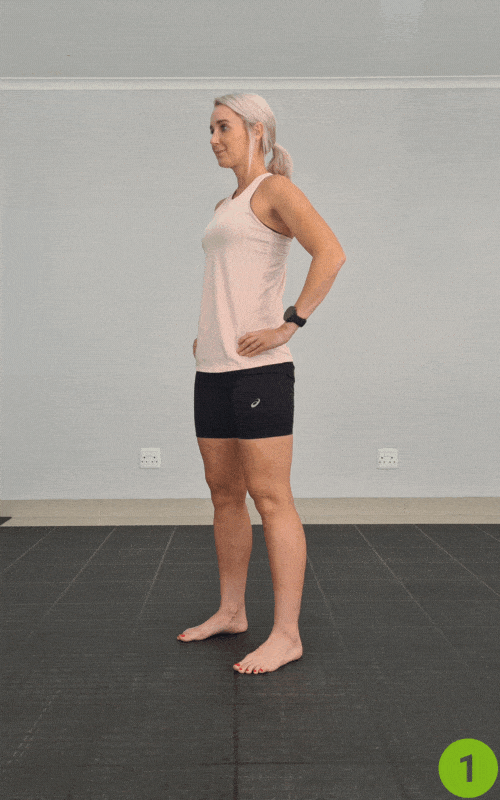
- Begin in an upright standing position with your feet slightly wider than shoulder-width apart, maintaining good alignment with your head, shoulders, and hips.
- Tighten your abdominal muscles.
- Bend your knees and hinge through your hips to lower your seat into a deep squat as you raise your arms in front of your body, up to shoulder height.
- Make sure your knees stay behind your toes.
- Raise back up to an upright standing position, squeezing your glutes at the top position.
- Repeat the movement. Start with 1 set of 10 repetitions.
6. Squat with Overhead Reach
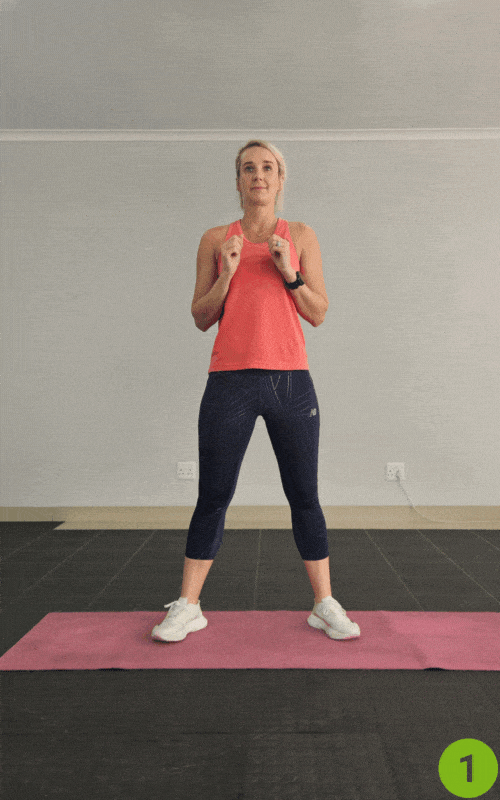
- Begin in an upright standing position with your feet slightly wider than shoulder-width apart, maintaining good alignment with your head, shoulders, and hips.
- Bend your arms to position your hands in front of your body at chest height.
- Engage your core. Bend your knees and hinge through your hips to lower your seat into a squat position.
- Keep your knees behind your toes.
- Raise back up to an upright standing position, bend your upper body to one side, and reach over your head with your arm.
- Return to the starting position and repeat the sequence of movements, alternating sides.
- Start with 1 set of 5 repetitions on each side.
- To make this exercise more challenging, hold light dumbbells, soup cans, or water bottles for added resistance.
7. Side Reaches

- Begin in an upright standing position with your feet wider than shoulder-width apart, maintaining good alignment with your head, shoulders, hips, and legs.
- Bend your arms to position your hands at chest height.
- Contract your core, twist your upper body to one side, and reach across your body in a punching motion.
- Repeat the movement on the opposite side.
- Start with 1 set of 10 repetitions on each side.
8. Bicep Curls
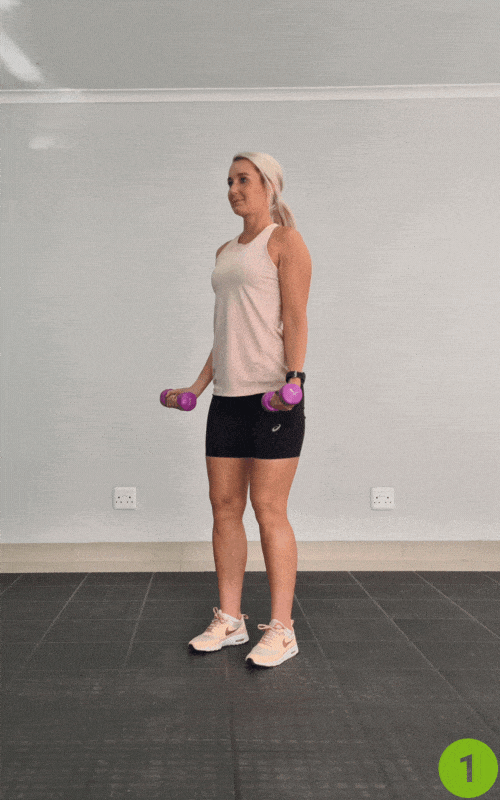
- Begin in an upright standing position with your feet shoulder-width apart, maintaining good alignment with your head, shoulders, hips, and legs.
- Place your arms at your sides. Engage your core and keep your upper arms aligned with your body.
- Bend your elbows to bring your hands up to shoulder height.
- Lower your arms to the starting position and repeat the movement. Start with 1 set of 10 repetitions.
9. Tricep Kickbacks
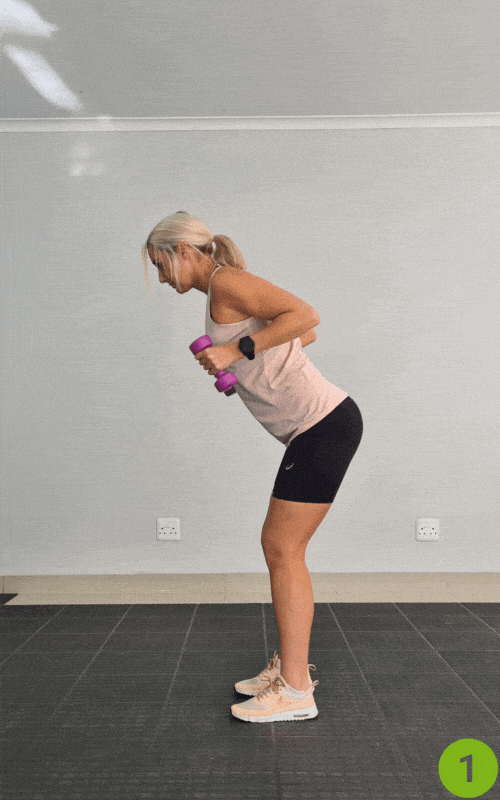
- Begin in an upright standing position with your feet shoulder-width apart, maintaining good alignment with your head, shoulders, hips, and legs.
- Bend your arms, keep your upper arms aligned with your body, and position your hands at chest height.
- Engage your core. Hinge your hips and slightly bend your upper body forward.
- Straighten your arms, stopping when your hands are just past your hips.
- Bend your arms to return to the starting position.
- Repeat the movement. Start with 1 set of 10 repetitions.
10. Good Mornings
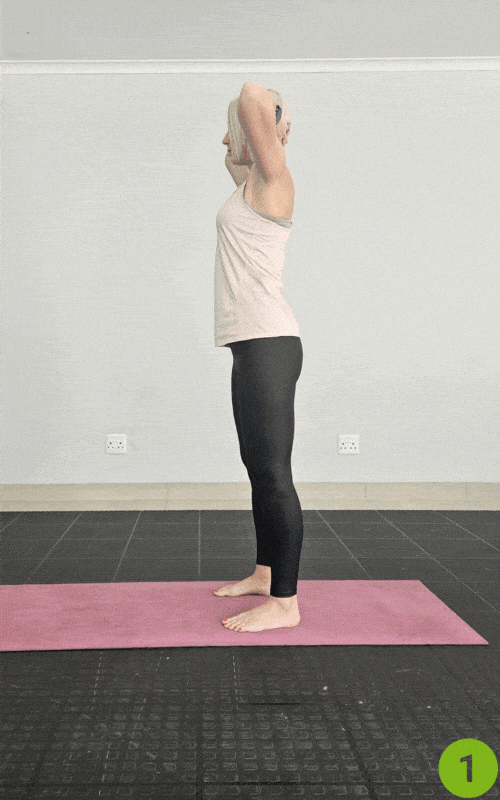
- Begin in an upright standing position with your feet slightly wider than shoulder-width apart, maintaining good alignment with your head, shoulders, hips, and legs.
- Interlace your fingers behind your head or hold your hands at your ears.
- Contract your abdominal muscles and pivot through your hips to bend your upper body forward.
- Ideally, your back should be parallel to the floor.
- Hold this position for a couple of seconds.
- Raise back up to the starting position and repeat the movement. Start with 1 set of 10 repetitions.
11. Burpees
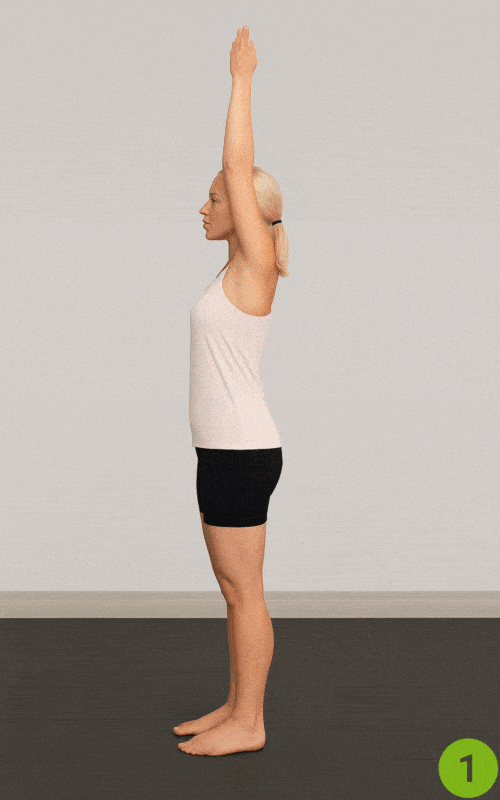
- Begin in an upright standing position, maintaining good alignment with your head, shoulders, hips, and legs.
- Extend both arms overhead. Lower your arms, then bend your knees and hinge from your hips to lower your hands to the floor. Hop back with both feet to move into a straight-arm plank position.
- Hop forward with both feet, then raise back up to an upright standing position, extending both arms overhead.
- Lower your arms to return to the starting position and repeat the sequence of movements. Start with 1 set of 5 repetitions.
This high-intensity move combines strength training and endurance exercise, activating multiple muscles, helping you burn calories, and boosting energy in short periods.
Core & Mobility Phase: Strength + Flexibility
1. Hip Presses
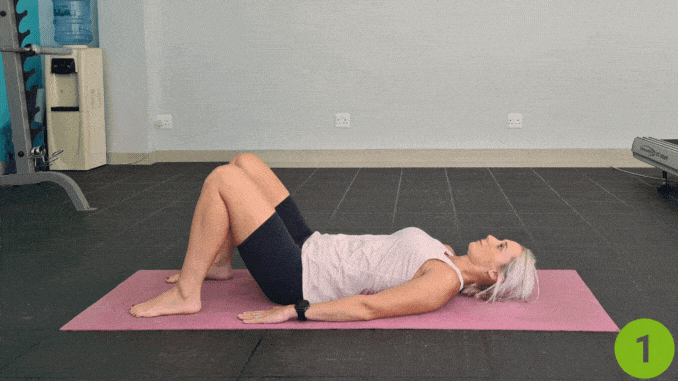
- Lie on your back on the floor with your knees bent and your feet flat, relaxing your upper body.
- Place your arms at your sides. Contract your abdominal area, then push from your heels to lift your hips, squeezing your glutes at the top position.
- Lower your hips to the starting position and repeat the movement. Start with 1 set of 10 repetitions.
Great for strengthening glutes and improving blood flow to the lower body.
2. Donkey Kicks
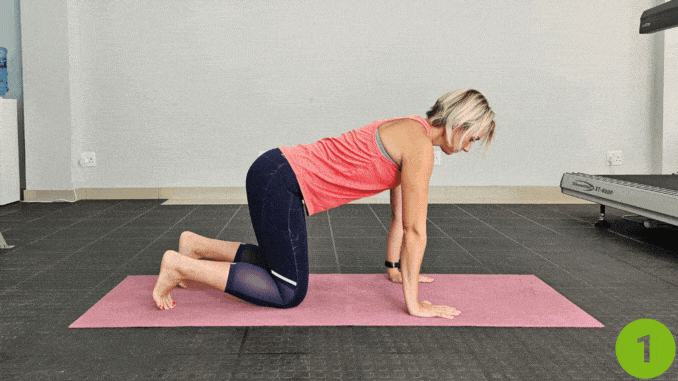
- Begin in a 4-point position, with your knees below your hips and your hands beneath your shoulders.
- Tighten your core and lift one heel towards the ceiling, squeezing your glutes at the top position.
- Lower your leg down to the starting position and repeat the movement.
- Start with 1 set of 10 repetitions on each side.
This strengthens the glutes, which are essential for posture, power, and movement efficiency.
3. Child’s Pose
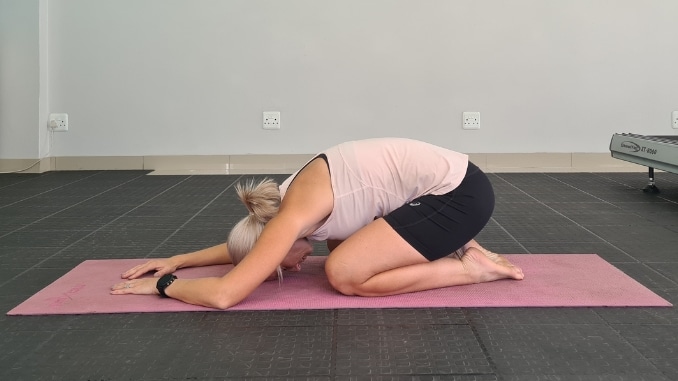
- Begin in a 4-point position, with your knees below your hips and your hands beneath your shoulders.
- Tighten your core, shift your hips back to your feet, and extend your arms overhead.
- Lower your forehead to the floor and relax your mid-back area for a light stretch.
- Hold this position for several deep belly breaths, in through your nose and out through your mouth.
- Start with 1 set of 1 repetition with a 10-second hold.
Enhances nervous system recovery and promotes energy renewal between sets.
4. Reverse Push-Ups

- Begin in a plank position with your hands beneath your shoulders, maintaining good alignment with your head, shoulders, hips, and toes.
- Engage your core and bend your arms to slowly lower your body to the floor.
- Push up to your knees, then straighten your arms to return to a 4-point position.
- Repeat the sequence of movements.
- Start with 1 set of 5 repetitions.
Strengthens chest, arms, and core muscles, helping you burn more calories.
5. Bicycle Crunches
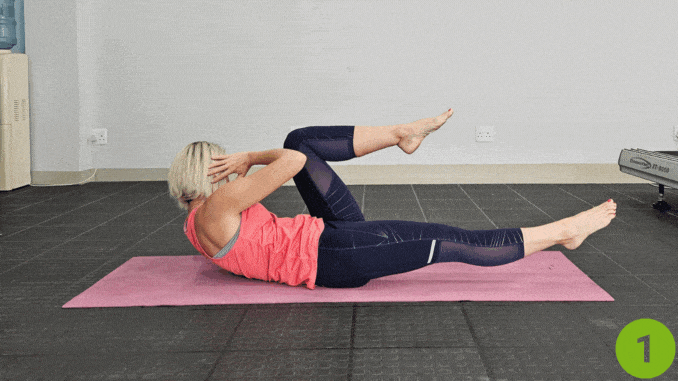
- Lie on your back with your knees bent and feet flat on the floor.
- Place your hands either by your ears or interlace your fingers behind your head.
- Raise your knees to 90-degree angles.
- Engage your core and twist your upper body to one side to bring your bent knee towards your opposite elbow as you straighten your opposite leg.
- Keep your heel hovering slightly above the floor.
- Return to the starting position and repeat the movement on the opposite side.
- Start with 1 set of 10 repetitions on each side.
Targets obliques, improves muscle strength, and boosts core endurance, which can aid in overall fat reduction when combined with a balanced diet.
Cool Down Phase: Regenerate & Stretch
1. Rest with Stretch
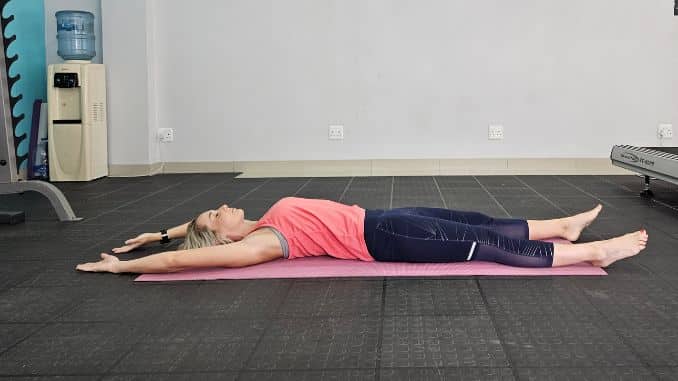
- Lie on your back on the floor, maintaining good alignment with your head, shoulders, hips, and legs.
- Engage your core and raise your arms overhead as you stretch your entire body.
- Hold this position for several deep belly breaths, in through your nose and out through your mouth.
- Relax and return to the starting position.
Encourages muscle recovery and helps reduce post-exercise fatigue.
2. Reverse Sit-Ups
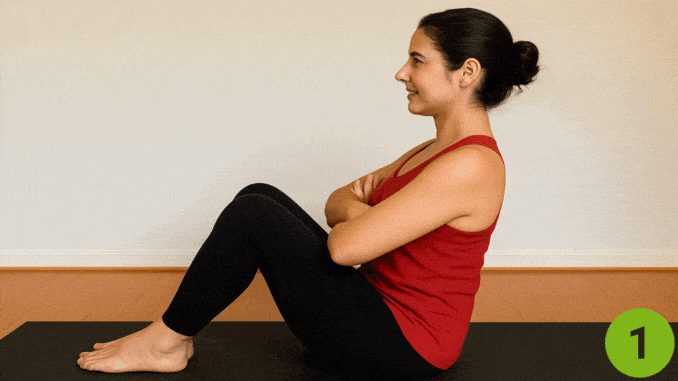
- Begin in an upright sitting position on the floor with your knees bent and your feet flat on the floor. Maintain good alignment in your upper body.
- Extend both arms in front of your body at chest height.
- Engage your core and very slowly lower your upper body down to the floor.
- At the bottom position, raise your arms overhead.
- Return to the starting position and repeat the movement.
- Start with 1 set of 10 repetitions.
A slow, controlled resistance exercise that improves spinal mobility.
3. Seated Bound Angle

- Begin in an upright sitting position on the floor, maintaining good alignment with your head, shoulders, and hips.
- Bring the soles of your feet together and lower your knees out at your sides.
- Hold onto your feet with your hands, pull your heels closer to your body, and elongate your spine.
- Hold this position for several deep belly breaths, in through your nose and out through your mouth.
- Start with 1 set of 1 repetition, holding for 10 seconds.
4. Seated Forward Fold
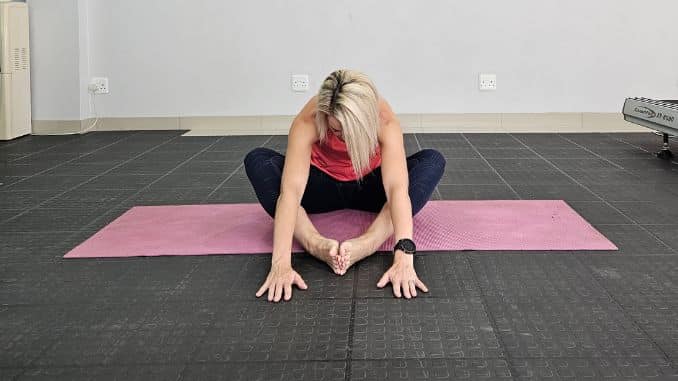
- Begin in an upright sitting position on the floor, maintaining good alignment with your head, shoulders, and hips.
- Bring the soles of your feet together and lower your knees out at your sides.
- Engage your core and hinge from your hips to lean your upper body forward.
- Keep your spine long, extend your arms overhead, and place them on the floor.
- Hold this position for several deep belly breaths, in through your nose and out through your mouth.
- Start with 1 set of 1 repetition, holding for 10 seconds.
5. Seated Single Leg Forward Fold
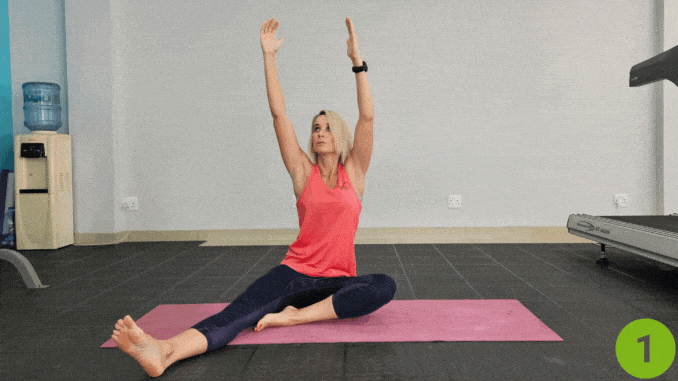
- Begin in an upright sitting position on the floor, maintaining good alignment with your head, shoulders, and hips.
- Bring the soles of your feet together and lower your knees out at your sides.
- Straighten one leg and position the foot of your bent leg against the inner thigh of your extended leg.
- Engage your core and hinge from your hips to lean your upper body forward over your straight leg.
- Keep your spine long and reach for your foot with both hands.
- Hold this position for several deep belly breaths, in through your nose and out through your mouth.
- Return to the starting position and repeat the movement on the opposite side.
- Start with 1 set of 1 repetition on each side, holding for 10 seconds.
6. Walk the Dog
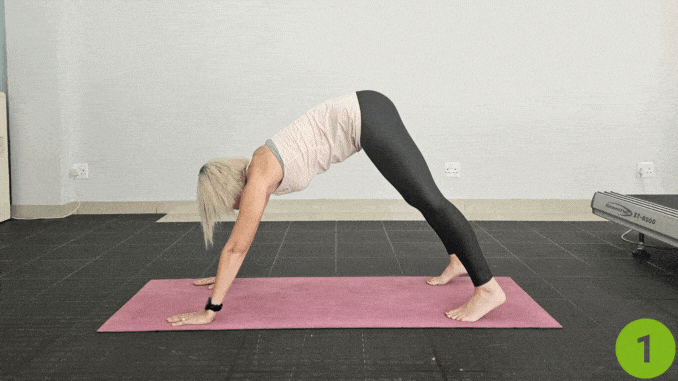
- Move into a 4-point position with your knees below your hips and your hands beneath your shoulders.
- Tighten your abdominal muscles and push back with your arms, straightening your legs as you lift your hips.
- Alternate slowly bending each knee to feel a light stretch through the Achilles tendon and calves.
- Start with 5 repetitions on each side.
Promotes better cardiovascular circulation and enhances post-exercise blood flow.
Nutrition & Recovery: Fuel for Strength and Energy

To get the most from your strength training for energy, focus on proper nutrition and recovery. After a workout, your muscles need fuel—aim for meals with lean protein, complex carbs, and healthy fats to support muscle recovery and replenish energy levels.
The American College of Sports Medicine recommends 1.2 to 1.7g of protein per kilogram of body weight daily to promote muscle growth. Don’t forget hydration—water aids muscle function and overall health. And rest is just as critical. Recovery helps prevent injury and keeps your energy high for your next workout.
Dr. Stuart Phillips, a leading protein metabolism researcher, explains that “muscle protein synthesis is maximized when protein intake is evenly distributed throughout the day.”
This supports the American College of Sports Medicine's guidelines of 1.2–1.7 g/kg/day of protein for active individuals. Consuming high-quality protein—such as lean meats, dairy, eggs, or plant-based sources—after training supports muscle repair, growth of lean tissue, and a higher metabolic rate.
Injury Prevention: Train Smart, Stay Strong

Avoid injury and keep your routine consistent with smart prep and progression. Begin each session with a warm-up and end with stretching or foam rolling to support flexibility and prevent strains.
Start light, especially if you're new to resistance training, and gradually increase the weight lifted or intensity. Listen to your body—take breaks when needed. The National Institute of Arthritis and Musculoskeletal and Skin Diseases recommends working with a pro to build a safe plan for your fitness goals.
Mental Health: Strength for Mind and Mood
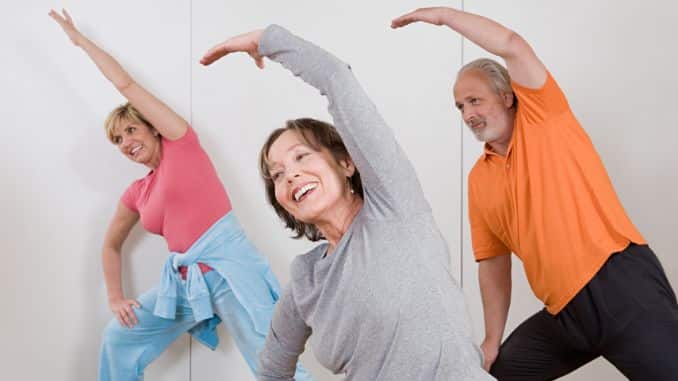
Exercise doesn't just build muscle—it also boosts your mind. Both aerobic activity and resistance exercise help reduce stress, ease anxiety, and improve mood through the release of endorphins.
A meta-analysis shows that strength training may even be effective in treating depression. Plus, regular movement supports better sleep—a major factor in mental health. The U.S. Department of Health and Human Services suggests at least 150 minutes of moderate or 75 minutes of vigorous aerobic exercise [³] weekly.
By moving regularly, you’re not only building a stronger body—but also a brighter, more resilient mind.
Final Thoughts
Whether you’re using free weights, your body weight, or just a mat, this strength training for energy routine offers a positive effect on your health at every level, from the American College of Sports Medicine to promoting more mitochondria. Endurance athletes can also benefit from strength training, as it supports muscular efficiency, injury prevention, and overall performance.
Certain types of strength training for energy can also enhance muscle cell energy production over time. Tracking the weight lifted during workouts is important to monitor progress and optimize energy gains.
Don’t underestimate what a single workout can do. With regular exercise and intentional resistance training, you’re not just strengthening muscles—you’re energizing your life.
Boost your energy and health with strength training! Check out our 10 Easy Movements for Increased Energy designed to build muscle, enhance metabolism, and support lasting vitality—no gym needed. Start today!
FAQ's
How much protein should I eat after strength training?
Aim for 20–30 grams of protein within 30–60 minutes after your workout to support muscle recovery. The ACSM recommends a total daily intake of 1.2–1.7 g/kg of body weight for active individuals.
Can hydration affect my strength training results?
Yes! Dehydration reduces strength output, slows recovery, and increases the risk of cramps or dizziness. Drink water consistently throughout the day—not just during your workout.
Is it okay to strength train every day?
Most people benefit from at least one rest or active recovery day per week. Working the same major muscle groups back-to-back without recovery can lead to overuse injuries or fatigue.
What are good sources of protein for strength training?
Some of the best include:
- Lean meats (chicken, turkey, fish)
- Eggs
- Greek yogurt
- Legumes
- Protein shakes (especially after training for convenience)
How do I know if I'm recovering properly?
Signs of good recovery include:
- Improved energy levels
- Decreased muscle soreness
- Consistent or improved performance
- Better sleep quality

